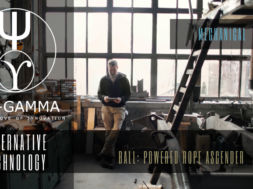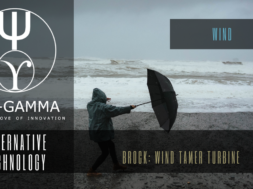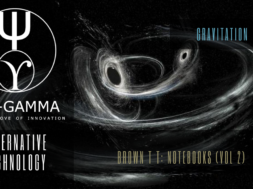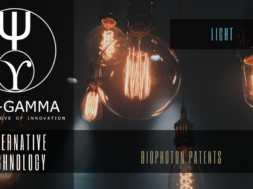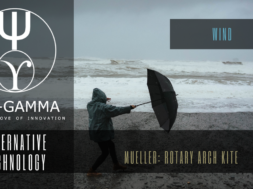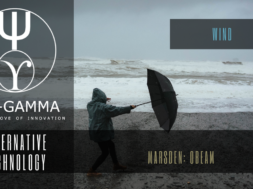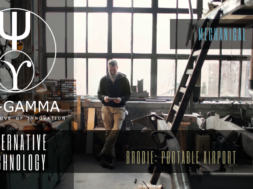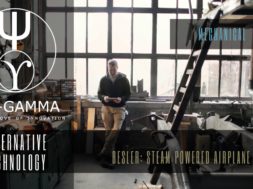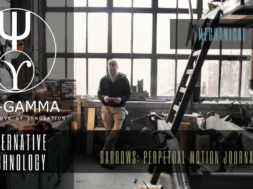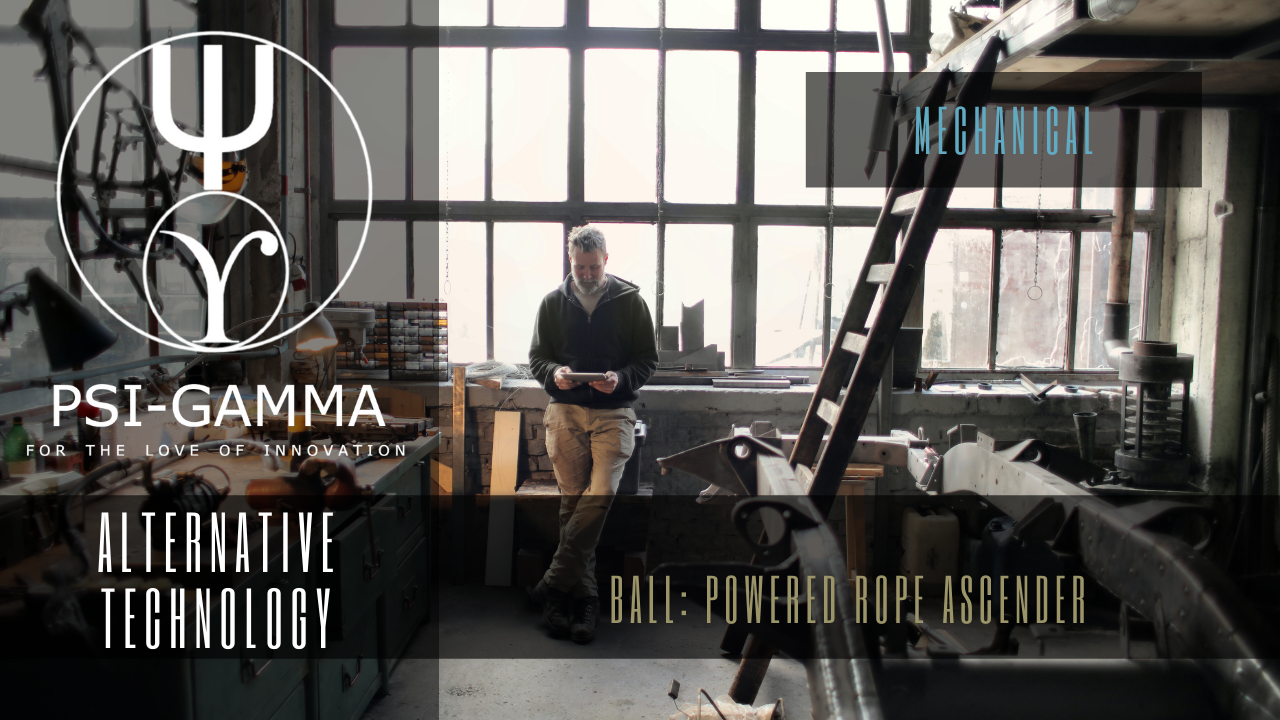
Ball: Powered Rope Ascender
The Atlas Power Ascender, now known in the U.S. Military as the APA, is a powerful tool that enables “reverse rappelling” up buildings and other vertical surfaces at unprecedented speeds.
Using Atlas Devices’ patented rope interaction design, the lightweight APA can pull a fully-loaded soldier or firefighter up a rappelling line at up to 10 ft/sec, as well as tow vehicles and even remotely move equipment and casualties.
With the capability to reach the top of a building or cliff in only seconds, new advantages are gained in urban warfare, rescue operations, industrial access, and beyond.
Nathan Ball
Nathan “Nate” Ball’s passion for invention was coursing through his veins long before he could define the word. He recalls digging up the family garden at two years old to build, wreck and rebuild mud dams and underground forts. In fourth grade he created a bottle-rocket launcher that shot two-liter bottles of water 100 feet skyward. This was followed by a hovercraft powered by a vacuum cleaner motor that he constructed in sixth grade.
By the time Ball was in the eighth grade, he was attempting to build a Tesla coil in his parent’s garage, making capacitors out of glass bottles and aluminum foil. “I saw Tesla coils on the Internet shooting lightening,” said Ball. “It was the coolest thing I’d ever seen, and I knew I had to build one.”
Amazingly, Ball never touched a machine tool until he reached college. He credits limited resources during his formative years to his ability to think unconventionally about problems and engineer efficient solutions.
Now 23, Ball is pursuing his Master of Science in Mechanical Engineering at the Massachusetts Institute of Technology and intends to graduate in 2007. He earned his Bachelor of Science in Mechanical Engineering from MIT in 2005.
He currently researches his master’s thesis at MIT’s BioInstrumentation Laboratory, which is run by his advisor, Hatsopoulos Professor of Mechanical Engineering Ian W. Hunter. Under Hunter and Research Scientist Andrew Taberner, another advisor, Ball was challenged to use the lab’s novel Lorentz-force actuator to create a dual-action, rapid-fire delivery technology that increased drug volume delivery, which he created within two months.
Now awaiting livestock trials, Ball and his colleagues anticipate the needle-free injection technology having applications in animal husbandry, and they hope it may someday be employed for safe, inexpensive, mass inoculation of humans in developing and developed countries. Commercialization of the work is funded in part by partner Norwood Abbey, Inc. of Melbourne, Australia.
Additionally, in 2004, Ball founded Atlas Devices, LLC with three other mechanical engineering students at MIT to develop and commercialize the ATLAS Powered Rope Ascender, which uses a rope-handling mechanism conceived by Ball. This portable device can raise more than 250 pounds at 10 feet per second, giving rescuers, emergency personnel and soldiers faster and more controllable climbing capabilities. The U.S. Army recently awarded funding for their invention.
Ball is a co-applicant of six patents and the co-author of numerous peer-reviewed articles. His awards and achievements include the SAIC Award in the 2005 Soldier Design Competition, sponsored by the Institute for Soldier Nanotechnologies at MIT, for his team’s ATLAS Powered Rope Ascender. He also won the Luis DeFlorez Award for outstanding ingenuity and creativity from MIT’s Department of Mechanical Engineering in 2005 for an electric scooter.
Inspired by his mother, who is a music teacher, and father, who is an engineer, Ball also enjoys sharing his passion for science and invention with others. In February 2007, Ball will be featured as a mentor to eight budding engineers as co-host of PBS’s new series “Design Squad.” The show aims to excite middle-school students about science and engineering by combining elements of reality TV with fun and educational engineering challenges. Additionally, Ball also mentors fifth grade boys in science and engineering at Fletcher Maynard Academy in Cambridge, Mass.
Ball is a native of Newport, Oregon where he was raised with his two sisters. He is a two-time NCAA All-American pole-vaulter and MIT’s indoor/outdoor record holder in the sport (16′ 6″ indoor, 16′ 8 ¾” outdoor). He currently serves as the school’s head pole vault coach.
Ball is also trained in classical piano. For fun, he enjoys playing jazz keyboard and beat-boxing.
Current Update:
Ball received his M.S. (2007) and B.S. (2005) in mechanical engineering at the Massachusetts Institute of Technology. For his master’s thesis at MIT’s BioInstrumentation Laboratory, Ball was challenged by advisors, Hatsopoulos Professor of Mechanical Engineering Ian W. Hunter and Research Scientist Andrew Taberner, to use the lab’s novel Lorentz-force actuator to create a dual-action, rapid-fire delivery technology that increased drug volume delivery, which he created within two months.
MIT GRADUATE STUDENT WINS $30,000 LEMELSON-MIT STUDENT PRIZE FOR LIFE-SAVING INVENTIONS
Nathan Ball’s inventions include a device to “fly” to tops of buildings and another to significantly improve mass inoculations
CAMBRIDGE, Mass. (February 14, 2007) – The ability to leap tall buildings in a single bound used to be the stuff of comic-book fantasy. Nathan Ball, a 23-year-old graduate student at the Massachusetts Institute of Technology and this year’s winner of the $30,000 Lemelson-MIT Student Prize, has invented a device that makes the fantasy a reality.
With the help of Ball’s ATLAS Powered Rope Ascender, a fully loaded firefighter could reach the top of a 30-story building in only 30 seconds, compared to the six minutes or more it often takes to trudge up stairs with 80 to 100 pounds of equipment. The device, which is the size of a hand-held power tool, can lift a 250-pound load more than 600 feet into the air at nearly 10 feet per second, all on a single battery charge.
“Ingenuity, creativity and passion seem to course through Nate’s blood,” said Merton Flemings, director of the Lemelson-MIT Program, which sponsors the annual award. “His battery-powered rope ascender and needle-free injection technology both have life-saving capabilities and many commercial applications.”
“Nate is also an inspiring and committed mentor for young inventors. This combination of attributes made him our top choice for this year’s $30,000 Lemelson-MIT Student Prize,” Flemings added.
Up, Up and Away!
In November 2004, Ball and three colleagues entered the Soldier Design Competition sponsored by the MIT Institute for Soldier Nanotechnologies. The competition called for a high-powered device to enable rapid vertical mobility.
Ball called the challenge unprecedented, as the original specifications called for a device that weighed less than 25 pounds and could lift 250 pounds 50 feet into the air, in five seconds. “That’s more than five horsepower in a 25-pound package,” he explained. “That’s a power-to-weight ratio higher than a Dodge Viper’s — we did the math. To have that much power in that small of a package is a heck of a challenge.”
Through a combination of resourcefulness and “the highest-tech equipment we could afford,” such as drill batteries and a few high-power density motors, Ball and his colleagues invented a device that could hoist 250 pounds of weight 50 feet into the air in seven seconds — only two seconds slower than the competition’s specification.
The novel aspect of the ATLAS ascender is its rope-handling mechanism. Similar to the way an anchor is raised and lowered on a ship, the device relies on the capstan effect, which produces a tighter grip each consecutive time a rope is wrapped around a cylinder. The grip continues to tighten as more weight is applied to the line.
In his design, a standard-sized rope (between three-eighths and five-eighths of an inch) is weaved between a series of specially configured rollers that sit on top of a turning spindle. As the battery-powered spindle rotates, it continuously pulls rope through the device. “We currently have three patents pending for the rope interaction and other iterations on the device” said Ball.
Ball and his colleagues founded Atlas Devices, LLC to develop and market the ATLAS Powered Rope Ascender. He has upgraded the original design, and the device is now powered by high-density, lithium-ion batteries created by A123Systems. Ball said the new power system immediately dropped the device’s weight by several pounds and significantly increased its speed.
“The latest configuration weighs 20 pounds and peaks at 10 feet per second,” he said. “A123Systems has a 150-foot steam tower we were able to use for testing. We successfully completed a 100-foot continuous ascent to the tower’s platform in 14 seconds.”
Ball envisions his invention having practical applications in rescue work, recreational climbing and cave exploration, as well as urban warfare situations. “It can help people complete tasks more efficiently and without depleting energy they would otherwise use climbing ladders and carrying heavy gear,” he said.
Hit Me With Your Best Shot
Another of Ball’s stand-out inventions is an improvement in the needle-free injection technology developed at MIT’s BioInstrumentation Laboratory. Under the direction of his advisors Ian W. Hunter and Andrew Taberner in the BioInstrumentation Laboratory, Ball was challenged to use the lab’s novel Lorentz-force actuator to create a dual-action, rapid-fire delivery technology that increased drug volume delivery.
Within two months, he had not only come up with a solution to the problem, but had built and tested a prototype device.
“Nate’s achievement is simply breathtaking and will have potentially a huge impact on drug delivery and, hence, healthcare,” said Ball’s advisor Professor Hunter.
Now awaiting livestock trials, Ball and his colleagues anticipate the needle-free injection technology having applications in animal husbandry. Beyond that, they hope the device may someday be employed for safe, inexpensive, mass inoculation of humans in developing and developed countries. Commercialization of the work is funded in part by partner Norwood Abbey, Inc. of Melbourne, Australia.
Inventor, Student, Reality-Show Host
Ball’s interest in invention does not stop with his own creations; he also dedicates himself to mentoring and advising aspiring inventors.
“Coming from a family of teachers and having such strong support from my parents, I felt it imperative to share that with other young inventors,” he said. “My parents helped me find my passion early in life and instilled in me a way to maintain it. To help other young inventors discover science is amazing and watching their first moment of discovery is very rewarding.”
Ball has been deeply involved as a technical advisor and co-host of “Design Squad,” a new engineering-based reality show for kids ages 9-13 that will air nationally on PBS beginning in February 2007. He helped brainstorm and test challenge ideas that he said would “require clever problem solving, ingenuity, and some classic mess-making.” Ball hopes that through this program, kids will be empowered to explore and embrace the elements of engineering that surround them each day.
Program Expands to Recognize Other Exceptional Inventors
In its ongoing effort to expand its reach and recognize outstanding up-and-coming inventors, the Lemelson-MIT Program is offering two new $30,000 Student Prizes this year.
Michael Callahan is the inaugural winner of the Lemelson-Illinois Student Prize at the University of Illinois at Urbana-Champaign. He is a graduate student in Industrial and Enterprise Systems Engineering who has invented a method to intercept neurological signals near the source of vocal production and convert the signals into speech. He hopes to make it possible for people with limited speech or movement abilities to communicate.
On February 16, the first recipient of the Lemelson-Rensselaer Student Prize at Rensselaer Polytechnic Institute will be announced by Lemelson Foundation chair Dorothy Lemelson, Rensselaer President Shirley Ann Jackson and Alan Cramb, dean of the School of Engineering. Details about the winner will be posted on www.rpi.edu/lemelson/.
On May 3, the winners of these Student Prizes will join together for a panel discussion at the Museum of Science, Boston. The 3:00 p.m. panel is open to the public and included in the Exhibit Hall admission.
About the $30,000 Lemelson-MIT Student Prize
The $30,000 Lemelson-MIT Student Prize is awarded annually to an MIT senior or graduate student who has created or improved a product or process, applied a technology in a new way, redesigned a system, or demonstrated remarkable inventiveness in other ways. A distinguished panel of MIT alumni and associates including scientists, technologists, engineers and entrepreneurs chooses the winner.
About the Lemelson-MIT Program
The Lemelson-MIT Program recognizes outstanding inventors, encourages sustainable new solutions to real-world problems, and enables and inspires young people to pursue creative lives and careers through invention.
Jerome H. Lemelson, one of the world’s most prolific inventors, and his wife Dorothy founded the Lemelson-MIT Program at the Massachusetts Institute of Technology in 1994. It is funded by the Lemelson Foundation, a private philanthropy that celebrates and supports inventors and entrepreneurs in order to strengthen social and economic life. More information on the Lemelson-MIT Program is online at http://web.mit.edu/invent/.

